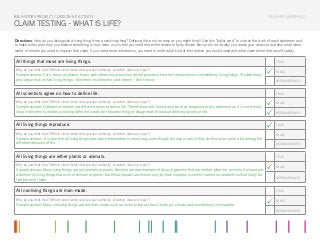
Testing Claims: Making Claims About Life
- 1. TEACHER MATERIALS CLAIM TESTING - WHAT IS LIFE? Directions: How do you distinguish a living thing from a nonliving thing? Defining life is not as easy as you might think! Use this “ballot card” to vote on the truth of each statement and to make notes as to why you believe something is true, false, or you feel you need more information to fairly decide. Be sure to write why you made your decision and also what claim tester or testers you used to support that claim. If you need more information, you need to write what kind of information you would need and what claim tester that would satisfy. All things that move are living things. TRUE Why do you think that? (Which claim testers did you use: authority, evidence, intuition, logic?) Sample answer: Cars, trains, airplanes, boats, and robots move, but they do not possess the other characteristics exhibited by living things. Students may also argue that certain living things – like trees, mushrooms, and lichens – don’t move. FALSE NEED MORE INFO All scientists agree on how to define life. TRUE Why do you think that? (Which claim testers did you use: authority, evidence, intuition, logic?) Sample answer: Different scientists use different terms to define life. “Need more info” would also be a fair response to this statement as it is not entirely clear if different scientists are using different words for the same thing or disagree on the actual defining factors of life. FALSE NEED MORE INFO All living things reproduce. TRUE Why do you think that? (Which claim testers did you use: authority, evidence, intuition, logic?) Sample answer: It is true that all living things reproduce themselves in some way, even though the way in which they do this varies quite a bit among the different domains of life. FALSE NEED MORE INFO All living things are either plants or animals. TRUE Why do you think that? (Which claim testers did you use: authority, evidence, intuition, logic?) Sample answer: Many living things are not animals or plants. Bacteria are one example of living organisms that are neither plant nor animals. Archaea are a domain of living things that are not animals or plants, but these species are known only by their complex, scientific names, so students will not likely be familiar with these. FALSE NEED MORE INFO All nonliving things are man-made. TRUE Why do you think that? (Which claim testers did you use: authority, evidence, intuition, logic?) Sample answer: Many nonliving things are not man-made, such as rocks, minerals, fossil fuels, air, clouds, and snowflakes, for example. FALSE NEED MORE INFO BIG HISTORY PROJECT / LESSON 5.0 ACTIVITY
- 2. Name: Date: STUDENT MATERIALS CLAIM TESTING - WHAT IS LIFE? Directions: How do you distinguish a living thing from a non-living thing? Defining life is not as easy as you might think! Use this “ballot card” to vote on the truth of each statement and to make notes as to why you believe something is true, false, or needs more information to fairly decide. Be sure to write why you made your decision and also what claim tester or testers you used to support that claim. If you need more information then you need to write what kind of information you would need and what claim tester that may satisfy. All things that move are living things. TRUE Why do you think that? (Which claim testers did you use: authority, evidence, intuition, logic?) FALSE NEED MORE INFO All scientists agree on how to define life. TRUE Why do you think that? (Which claim testers did you use: authority, evidence, intuition, logic?) FALSE NEED MORE INFO All living things reproduce. TRUE Why do you think that? (Which claim testers did you use: authority, evidence, intuition, logic?) FALSE NEED MORE INFO All living things are either plants or animals. TRUE Why do you think that? (Which claim testers did you use: authority, evidence, intuition, logic?) FALSE NEED MORE INFO All nonliving things are man-made. TRUE Why do you think that? (Which claim testers did you use: authority, evidence, intuition, logic?) FALSE NEED MORE INFO BIG HISTORY PROJECT / LESSON 5.0 ACTIVITY
- 3. Name: Date: STUDENT MATERIALS CLAIM TESTING Directions: Decide if the claim passes each claim tester and provide evidence for your decisions. Claim Test Test Passed? (Yes, No, Don’t Know or Needs More Information) Why did you decide the claim passed (or did not pass) the claim tester? What evidence did you use to decide? Where did you get your evidence? Intuition • Does your gut reaction tell you the claim is reliable? • Do you feel that the claim is true? Authority • Does the person stating the claim have experience in the field? • Has the person making the claim made trustworthy claims in the past? Logic • Does the claim make sense to you and follow a clear line of reasoning? Evidence • Do you have facts that others can “see” that support the claim? BIG HISTORY PROJECT / WORKSHEET The claim you are testing:
